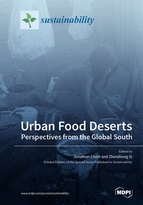Urban Food Deserts: Perspectives from the Global South
A special issue of Sustainability (ISSN 2071-1050). This special issue belongs to the section "Sustainable Agriculture".
Deadline for manuscript submissions: closed (31 October 2018) | Viewed by 56673
Special Issue Editors
Interests: global migration and development; rapid urbanization and food security in the Global South
Special Issues, Collections and Topics in MDPI journals
Special Issue Information
Dear Colleagues,
The industrialization of the urban food system, alongside the proliferation of supermarkets, has dramatically transformed the landscape of food accessibility in cities. In many countries, especially the US, the spatial consolidation of food provisioning has deprived many urban neighbourhoods of easy access to food, particularly foodstuffs integral to a healthy diet. These often socioeconomically disadvantaged urban areas are referred to as “food deserts”. However, studies of urban food deserts in cities of the Global South are sparse, given their complicated urban food systems with the strong presence of informal food economies and diverse food sources. This Special Issue calls for both empirical studies and theoretical discussions of urban food deserts in the Global South, with a focus on a broad range of issues such as food accessibility, food affordability, urban food sources, informal food economies, supermarketization and the food security characteristics and consequences of food deserts, as well as urban policies that contribute to or mitigate the existence and development of food deserts. Papers submitted to the Special Issue could approach these themes from various disciplinary and theoretical perspectives.
Dr. Jonathan Crush
Dr. Zhenzhong Si
Guest Editors
Manuscript Submission Information
Manuscripts should be submitted online at www.mdpi.com by registering and logging in to this website. Once you are registered, click here to go to the submission form. Manuscripts can be submitted until the deadline. All submissions that pass pre-check are peer-reviewed. Accepted papers will be published continuously in the journal (as soon as accepted) and will be listed together on the special issue website. Research articles, review articles as well as short communications are invited. For planned papers, a title and short abstract (about 100 words) can be sent to the Editorial Office for announcement on this website.
Submitted manuscripts should not have been published previously, nor be under consideration for publication elsewhere (except conference proceedings papers). All manuscripts are thoroughly refereed through a single-blind peer-review process. A guide for authors and other relevant information for submission of manuscripts is available on the Instructions for Authors page. Sustainability is an international peer-reviewed open access semimonthly journal published by MDPI.
Please visit the Instructions for Authors page before submitting a manuscript. The Article Processing Charge (APC) for publication in this open access journal is 2400 CHF (Swiss Francs). Submitted papers should be well formatted and use good English. Authors may use MDPI's English editing service prior to publication or during author revisions.
Keywords
- food deserts
- food sources
- food security
- urban food system
- food accessibility
- urban food policies
- informal food economy
- the Global South






